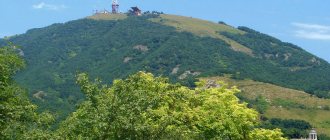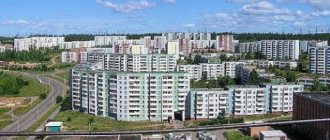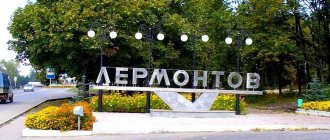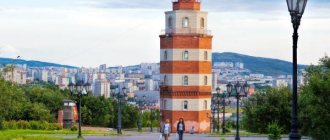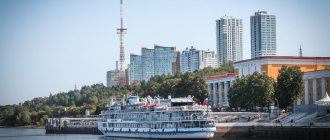Founded: 1780
Pyatigorsk celebrates City Day on
the 2nd Saturday of September
.
In 2021,
this date is
September 11
.
In 2021, due to the pandemic, mass events in honor of the city day are canceled or may be postponed
The eagle is the symbol of Pyatigorsk
Pyatigorsk
- a resort city in the Stavropol Territory of Russia, in the Caucasian Mineral Waters region.
The year the city was founded is considered to be 1780
, when the construction of the Konstantinogorsk fortress began - one of the fortifications of the Azov-Mozdok defensive line (1777) in the North Caucasus, which were created to strengthen the influence of the Russian Empire in this region.
And the history of Pyatigorsk as a resort city begins in 1803, when, by a special decree of Alexander I, the Caucasian hot mineral waters were recognized as medicinal, and it was decided to create a resort on their basis. The initial Russian settlement near the springs was the Konstantinogorsk Fortress, founded in 1780. The Goryachevodsk settlement arose near the fortress, which served as the foundation of the future city of Pyatigorsk.
Goryachevodsk was gradually built up. In 1812, the official Chernyavsky built a house for visitors near healing springs. This is how the first resort establishment in Pyatigorsk appeared. General A.P. Ermolov, who commanded Russian troops in the Caucasus, also did a lot for the development of the resort. A special construction commission created by Ermolov built wooden galleries, baths, gazebos, boulevards, gardens, etc.
The five-domed mountain Beshtau gave its name to the city. On May 14, 1830, the expanding village of Goryachevodsk, by government decree, was elevated to the status of a county town under the modern name Pyatigorsk. A year later, a new city development plan was approved and benefits were announced for those wishing to settle in Pyatigorsk. In 1837, there were 400 houses in Pyatigorsk, and there were more than a thousand residents.
In the 20th century, Pyatigorsk continues to develop, new health resorts are built, and the popularity of the resort is growing. During World War II, the city was occupied by German troops and partially destroyed.
In the post-war period, sanatoriums were restored, major hydrogeological studies and exploration work were carried out. Pyatigorsk receives new mineral springs (hot Narzan, salt-alkaline water like Essentuki and others). In 1970, Pyatigorsk was included in the list of historical cities of Russia.
Gazebo "Eolian Harp"
The city is rich
in attractions
: the house of M.Yu. Lermontov and the place of the poet's duel; the “Eolian Harp” gazebo, which offers a picturesque view of Elbrus, the Chinese gazebo, Diana’s Grotto, the Academic Gallery, Proval.
Interesting
that there is a narrow-gauge tram in Pyatigorsk. In Russia, besides Pyatigorsk, such a tram is only available in Kaliningrad.
More than 146 thousand people live in the city (2020).
Day of the city
celebrated in Pyatigorsk in September.
Geography
View of Pyatigorsk
“The air is clean and fresh, like a child’s kiss; the sun is bright, the sky is blue - what would seem to be more?” – this is what Mikhail Lermontov said about Pyatigorsk through the mouth of the “hero of our time” Pechorin. This is what you will probably think as soon as you get off the train and take a look at this cozy green town.
Pyatigorsk is located in the valley of the mountain river Podkumok, at the foot of the Mashuk and Beshtau mountains. If you look at the Pyatigorsk mountains from afar, it will seem that they grew up literally out of the blue, and this is to some extent true. The mountains of Pyatigorsk and the surrounding area are not related to the Greater Caucasus Range, although they are located in the Caucasus. These are laccolith mountains, or in other words, failed volcanoes. Millions of years ago, volcanic activity raged in the territory of the CMS, but the viscous magma was never able to reach the surface and only slightly raised the soil in some places. Where this happened, laccolith mountains grew. There are seventeen such mountains in the CMS, and the five-domed Beshtau is the highest among them. Its central peak reaches 1400 meters. The height of Mashuk is 993 meters, and given that the city itself is located at an altitude of 450-600 meters above sea level, you can easily (or almost easily) climb to the top of Mashuk on foot.
Mount Mashuk
The remaining fifteen laccolith mountains are scattered throughout the territory of the Caucasian Mineral Waters. At the foot of Zheleznaya and Razvalka the city of Zheleznovodsk grew up, to the south of Pyatigorsk there are twin sisters Yutsa and Jutsa, towards the city of Mineralnye Vody (not to be confused with the KMS region!) you can see mountains with “zoological” names: Camel, Bull and Snake. But Mount Dagger, which stood there, was unlucky - it was razed to the ground, as it prevented planes from taking off and landing.
Mount Beshtau
It is believed that mineral springs also owe their origin to the volcanic activity of laccolith mountains. How does this happen? Melted snow and storm water penetrates the sedimentary rocks of the mountains and flows slowly, at a speed of about 40 meters per year, from south to north. Along the way, it absorbs volcanic gases, is saturated with healing mineral salts and comes to the surface already mineralized, and in some places slightly carbonated!
Due to the fact that Pyatigorsk is located on a foothill plain, it is open to almost all winds. At the same time, the Beshtau and Mashuk mountains are not large enough to shelter the city from bad weather. Basically, eastern and western winds dominate in Pyatigorsk. They play a major role in shaping the climate of the resort city. In winter, eastern winds bring cold air from the steppe regions, forming low clouds, fog and frost. And in the summer, these same winds bring hot and dry weather to Pyatigorsk. In summer the temperature can reach 30-35 degrees Celsius, and in winter it most often stays around zero.
Pyatigorsk in winter
Author profile:
Hotels and resorts in Pyatigorsk
Spa treatment is not an easy job, requiring rest and recuperation. You need to relax after going for healing water in pleasant conditions - numerous hotels in Pyatigorsk are ready to offer them. The most expensive accommodation is at the Bristol Spa Hotel. One night in his apartment will cost 30,000 RUB. Hotels and guest houses offer rooms at prices ranging from 800-3000 RUB per person per night, depending on comfort and distance from the resort area. Apartments in Pyatigorsk can be rented both daily and for long periods. If you do without intermediaries, you can find simple but well-maintained housing at a price of 800 RUB, and for 3000-4000 RUB you can find apartments with luxurious furniture. Prices for accommodation and treatment in sanatoriums in Pyatigorsk range from 1400 to 3800 RUB per person per day.
Cafes and restaurants
The national composition of Pyatigorsk can be judged by the names of its cafes and restaurants - Russian, Armenian, Azerbaijani, Georgian, Ukrainian and Jewish cuisines are represented here. Of course, like any other modern city, Pyatigorsk cannot do without American fast food, Japanese sushi bars, Italian pizzerias and coffee shops.
The iconic gastronomic establishment of the city is the Eagle's Nest cafe. It is located on Mount Mashuk, on the second floor of the upper cable car station. Here you can taste national dishes of Caucasian cuisine, and from the windows you can enjoy an impressive view of the Great Caucasus Range. At the entrance to the Tsvetnik park in the historical building “Gukasov’s Coffee House” there is now an art cafe “Tete-a-tete”. Its owners maintain continuity and maintain the brand, offering their visitors delicious coffee.
You can have a snack and at the same time use free Wi-Fi in chain cafes - McDonald's, Subway and Mister Sloykin. It is better to try Caucasian cuisine in authentic khinkal and kebab shops - the average bill is 300-800 RUB. You can eat tasty and home-style food in local canteens; visitors note the cleanliness and good selection, the average bill is 300 RUB. During the allotted time, some cafes offer business lunches at a price of 200 RUB. In pastry shops and coffee shops you can enjoy sweets inexpensively - from 200 RUB. Dinner in a restaurant will cost from 1900 RUB per person.
- Which cafes and restaurants in Pyatigorsk are worth visiting?
Treatment in Pyatigorsk
Pyatigorsk is a multi-profile balneological and mud resort. Most resort facilities are located in the eastern part of the city. The main healing factors are hot hydrogen sulfide and radon mineral waters; the healing mud of Lake Tambukan is also widely used.
The main specialization of Pyatigorsk hospitals is diseases of the musculoskeletal system, skin, gynecological disorders, occupational diseases (vibration disease, occupational polyneuritis), pediatrics (treatment of children with consequences of birth injuries, childhood neurological disorders, as well as diseases of the digestive system).
The city owes its birth to sources of healing water, of which there are more than 40 in the city, and to the unique climate. Its construction took place under the patronage of Emperor Nicholas I and the highest military officials of Russia. Famous Italian architects Giuseppe and Giovanni Bernardazzi took part in the development of the architectural plan. The latter's surname is immortalized in the name of one of the central streets of this city.
Guides in Pyatigorsk
All guides in Pyatigorsk
Excursions
- City near Mashuk
- Caucasus with pleasure!
- Weekend on top
Excursions
- To Kislovodsk - the city of the sun and Narzan
- Ullu-Tau (health gorge)
- Honey Falls
All 37 excursions
Excursions of Andrey Aleksandrovich Shevtsov
- How mountains were blown up at CMV
- Excursions along the CMS at sunrise, sunset and at night
- Your fun Dombay
All 8 excursions
Roman's excursions.
- Thermal spring "Belovsky"
- Dombay
- Chegem waterfalls
All 21 excursions
Excursions by Vera Dyachkova
- Unknown park
- Amazing Essentuki
- Walking tour “History and fate of Kislovodsk”
All 5 excursions
All guides in Pyatigorsk
Districts
The entire resort life is built around the Tsvetnik and Proval microdistricts in the east of the city. They received their names in honor of the attractions of the same name - from the Tsvetnik park, a tour of the city begins for tourists, and it usually ends at the underground cave with Lake Proval. The residential area of Belaya Romashka, located in the northeast, is also attractive for living. Transport links connect it with all parts of the city. In good weather, a picturesque view of Elbrus opens from here. There is a convenient exit to Mount Mashuk through the site of Lermontov's duel.
What to try
Gastronomic establishments in Pyatigorsk offer a colorful mix of dishes from national cuisines - Ossetian pies, Russian pancakes, Karachay “khychin” and Greek “gyros”. However, there is one dish that can be found in almost every establishment - shish kebab. Here it is made from everything - meat, fish, vegetables and even fruits. It’s worth trying its fruity version at least once - juicy pineapple slices are layered with pieces of fat tail fat and fried on the grill. It is better to order dishes of Caucasian cuisine not in pretentious restaurants, but in small national eateries - where the locals themselves eat. Almost all vacationers take away memories of Pyatigorsk ice cream from the resort. The local cold storage plant makes it from natural ingredients of “Soviet” quality - you can taste real ice cream and popsicle only here.
Pyatigorsk for children
Together with your children, you can go to the Operetta Theater, where children's musical fairy tales are regularly shown. In the park named after Kirov and on the territory of the entertainment and restaurant complex "Park Rodnik" there are zoos, including contact ones. Terek Stud Farm invites little tourists on excursions and horse riding. The anti-cafe “Divan” and the educational toy store “Rebus” periodically host toy libraries. You can get acquainted with the collection of tropical and Caucasian insects at the Insect Museum, opened in the Academic Gallery. In addition to the impressive collection of dry exhibits, excursionists are presented with a collection of live insects - spiders, scorpions, cockroaches, stick insects and tropical beetles. In addition, chameleons, lizards, frogs and snakes live here.
5 things worth doing in Pyatigorsk
- Throw a coin into Kisa Vorobyaninov's hat at the Flower Garden.
- Sit at the table where Lermontov wrote Borodino.
- Buy a ticket from Ostap Bender so that “Fail, don’t fail.”
- Go through the Pyatigorsk Gate of Love.
- Take a bath in “shameless” baths.
Lermontovsky Pyatigorsk
Many historical places in Pyatigorsk are associated with the name of M. Yu. Lermontov. The poet first visited the waters at the age of 10 - his grandmother brought a sick child to Pyatigorsk. Fascinated by the beauty of these places, Lermontov returned here more than once - here he worked, and here he tragically ended his life’s journey. The center of the Lermontov Nature Reserve in the North Caucasus became the oldest quarter of Pyatigorsk. It contains the poet’s house, where he spent the last months of his life, and where his lifeless body was brought after the duel. Nearby is the Virzilin House, where the fatal quarrel between Lermontov and Martynov took place.
The name of Lermontov is inextricably linked with the history of Pyatigorsk: he visited here as a child, lived during his exile in the Caucasus, wrote the famous works “The Prophet”, “I Go Out Alone on the Road”.
The place of the duel at the foot of Mashuk and the original burial of the poet are marked by stone obelisks. The first monument to the poet in Russia was also erected here - in Pyatigorsk Park. Aeolian Harp, Elizabethan Spring, Lermontov's Grotto, Diana's Grotto, Proval, Lermontov Baths, House for Poor Officers, restaurant - all these attractions are in one way or another connected with the name of the poet, and some of them are dedicated to the lines of his immortal works.
Lakes and beaches of Pyatigorsk
The resort even has its own “sea” - the artificial lake Novopyatigorskoye is located in the southwest of the city in the area of the same name.
This is the only local body of water in which swimming is officially permitted. Every year, from the beginning of summer, the beach season starts on the lake. Vacationers here are offered landscaped beach areas, drinking fountains, catamaran rentals, and places for beach volleyball and football. For those who like to sit with a fishing rod, the “fishing” sector is allocated on the opposite side - they say that crucian carp, carp, grass carp, catfish and pike are found here. You can get to the beach by tram, minibus or train to the Novopyatigorsk platform. Salt lake Tambukan is located 12 km southeast of Pyatigorsk. It is considered the oldest Russian spa resort. In terms of iron sulfide content, Tambukan medicinal mud ranks one of the first in the country. These healing bottom sediments are used for cosmetic and medicinal purposes in all Caucasian health resorts. Due to the high mineral content, the lake appears black in any weather. From Pyatigorsk to Tambukan you can take route No. 19 to the final stop of the same name.
Types of Pyatigorsk
